Overview
In previous post, I described the configuration of a linux bridge and showed an experiment in which wireshark was used to analyze the traffic. In this article, I will discuss what happens when a bridge is created and how a Linux bridge works.
The source code related to bridge can be found here
Bridge Device
From Understanding Linux Network Internals:
In Linux, a bridge is a virtual device. As such, it cannot receive or transmit anything unless you bind one or more real devices to it.
After reading last article, somebody asked me, since a bridge is a L2 device,
why we see an IP address with it when we run ifconfig br0? The answer is, the
Linux implementation combines a bridge and a router together. We know that a
bridge has an uplink that can be connected to a router. Linux bridge makes this
connection internal to the kernel. And this router is actually the real device
it is bound to. We will discuss that part later. For understanding the bridge,
we can just treat this IP address as the bridge’s default gateway. And it is not
needed if we want a private bridge.
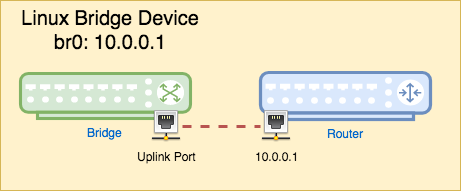
Bridge Data Structure
The definition of the net_bridge struct can be found
here.
Only some important fields are listed below:
struct net_bridge
{
spinlock_t lock;
struct list_head port_list;
struct net_device *dev;
spinlock_t hash_lock;
struct hlist_head hash[BR_HASH_SIZE];
bridge_id bridge_id;
...
}
port_list is the list of ports a bridge has. Each bridge can have at most
BR_MAX_PORTS(1024) ports. dev is a pointer to the net_device struct that
represents the bridge device. hash is the forwarding table with
BR_HASH_SIZE(256) entries.
Create a Bridge Device
A bridge can be created with command brctl addbr br0. It eventually calls ioctl
with request SIOCBRADDBR:
# strace brctl addbr br0
execve("/sbin/brctl", ["brctl", "addbr", "br0"], [/* 17 vars */]) = 0
...
ioctl(3, SIOCBRADDBR, "br0") = 0
...
If we search SIOCBRADDBR in the source code, we will see it is handled by
function br_ioctl_deviceless_stub, along with 3 other requests - SIOCGIFBR,
SIOCSIFBR and SIOCBRDELBR.
int br_ioctl_deviceless_stub(struct net *net, unsigned int cmd, void __user
*uarg) {
switch (cmd) {
case SIOCGIFBR:
case SIOCSIFBR:
...
case SIOCBRADDBR:
case SIOCBRDELBR:
...
}
...
}
The function is registered in the initialization function br_init.
int __init br_init(void) {
...
brioctl_set(br_ioctl_deviceless_stub);
...
}
br_ioctl_deviceless_stub calls br_add_bridge, which allocates a net_device
that represents the bridge and then adds this device to the kernel interfaces
using register_netdev.
int br_add_bridge(struct net *net, const char *name)
{
struct net_device *dev;
int res;
dev = alloc_netdev(sizeof(struct net_bridge), name, NET_NAME_UNKNOWN,
br_dev_setup);
...
res = register_netdev(dev);
...
return res;
}
alloc_netdev is defined as a macro and it is the stub of alloc_netdev_mqs,
which is in fact a generic method to allocate a net_device struct and is not
specific to the bridge. The bridge is represented as private data in the
net_device. (Private data is a piece of memory appended to the net_device
struct.) The callback function that alloc_netdev_mqs takes is used to set up
this private data part. In bridge case, the callback is br_dev_setup.
struct net_device *alloc_netdev_mqs(..., void (*setup)(struct net_device *), ...) {
struct net_device *dev;
size_t alloc_size;
...
alloc_size = sizeof(struct net_device);
if (sizeof_priv) {
/* ensure 32-byte alignment of private area */
alloc_size = ALIGN(alloc_size, NETDEV_ALIGN);
alloc_size += sizeof_priv;
}
/* ensure 32-byte alignment of whole construct */
alloc_size += NETDEV_ALIGN - 1;
p = kzalloc(alloc_size, GFP_KERNEL | __GFP_NOWARN | __GFP_REPEAT);
...
dev = PTR_ALIGN(p, NETDEV_ALIGN);
...
setup(dev);
...
return dev
}
br_dev_setup sets up the private data area of the net_device. It casts this
piece of memeory into net_bridge and initializes each field.
void br_dev_setup(struct net_device *dev) {
struct net_bridge *br = netdev_priv(dev);
...
dev->priv_flags = IFF_EBRIDGE;
br->dev = dev;
spin_lock_init(&br->lock);
INIT_LIST_HEAD(&br->port_list);
spin_lock_init(&br->hash_lock);
br->bridge_id.prio[0] = 0x80;
br->bridge_id.prio[1] = 0x00;
...
}
To summarize, the call stack of creating a bridge is:
ioctl(3, SIOCBRADDBR, "br0")
|- br_ioctl_deviceless_stub
|- br_add_bridge
|- alloc_netdev
|- br_dev_setup
|- register_netdev
After this step, we have a Linux bridge device. However, we do not have any interface bound to it, which means the bridge cannot transmit or receive anything yet.
Add an Interface
After the creation of a bridge, we can add interfaces (ports) to it. Though Understanding Linux network internals states that the bridge must be bound to a “real device”, I think this sentence is only partially true. It is true that a bridge device must be bound to a network interface. However, it does not necessarily need to be a “real device”, which means it does not need to be the interface of the real physical NIC. Even a tap interface can be bound to the bridge for it to function.
The command used to bind an interface is brctl addif br0 tap0. This is also
called “enslave”, which means we are making tap0 a slave of br0.
# strace brctl addif br0 tap0
execve("/sbin/brctl", ["brctl", "addif", "br0", "tap0"], [/* 17 vars */]) = 0
brk(NULL) = 0xf28000
...
ioctl(4, SIOCGIFINDEX, {ifr_name="tap0", }) = 0
close(4) = 0
ioctl(3, SIOCBRADDIF) = 0
It issues two ioctl requests - SIOCGIFINDEX and SIOCBRADDIF. The first one
is used to search the index of interface tap0 and the second one is used to
add the interface tap0 to the bridge. We only look into the second one.
SIOCBRADDIF is hanlded by br_dev_ioctl
int br_dev_ioctl(struct net_device *dev, struct ifreq *rq, int cmd) {
struct net_bridge *br = netdev_priv(dev);
switch (cmd) {
...
case SIOCBRADDIF:
case SIOCBRDELIF:
return add_del_if(br, rq->ifr_ifindex, cmd == SIOCBRADDIF);
}
...
}
add_del_if is a stub for br_add_if and br_del_if. In addition case,
br_add_if is called. Some important steps in br_add_if are listed below.
int br_add_if(struct net_bridge *br, struct net_device *dev) {
struct net_bridge_port *p;
... (Validation)
p = new_nbp(br, dev);
...
err = netdev_rx_handler_register(dev, br_handle_frame, p);
...
err = netdev_master_upper_dev_link(dev, br->dev);
...
list_add_rcu(&p->list, &br->port_list);
nbp_update_port_count(br);
...
if (br_fdb_insert(br, p, dev->dev_addr, 0))
netdev_err(dev, "failed insert local address bridge forwarding table\n");
...
return err;
}
Basically, br_add_if does the following things:
- Perform a series of validations to make sure that this device can be enslaved
to the bridge. Parts of the rules are: 1) non-ethernet like devices are not
allowed; 2) a device that is already being enslaved is not allowed; 3) the device
itself cannot be a bridge; 4)
IFF_DONT_BRIDGEshould not present in the device; etc. - Allocate and initialize a
net_bridge_portstruct. The port is later added to the bridge’sport_list. - Register a receive handler
br_handle_framefor the device. Frames sent to that device will be handled by this function. We will see what does this handler do later. - Enslave the device, which means making the bridge the master of this device.
- Add this device’s ethernet address to forwarding table as a local entry.
Note, in older version, the device is explicitly put into promiscuous mode in
br_add_if. In 4.0 kernel, this is handled by nbp_update_port_count function.
The following figure from “Anatomy of a Linux bridge” shows the relationshiop of functioins we metioned above.
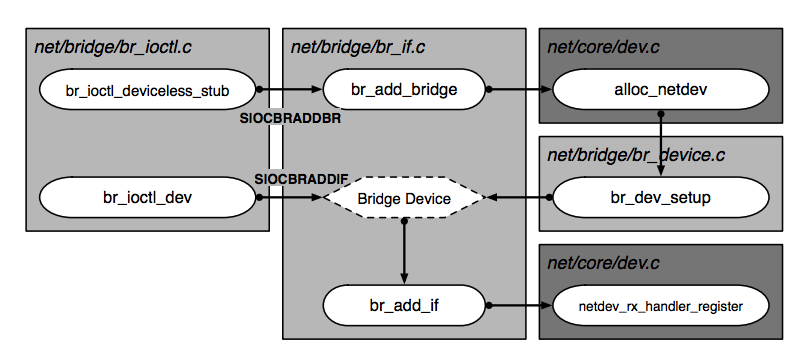
Forwarding Database
Forwarding database stores the MAC adress and port mapping. The implementation
uses a hash table (an array actually) of size BR_HASH_SIZE(256) as the
forwarding database. Each entry in the array stores the head of a
singlely-linked list (a bucket) which stores the entries whose MAC address hash
value falls into this bucket. See struct hlist_head hash[BR_HASH_SIZE] in the
net_bridge sturct above. The hash value of the MAC address is calculted by
br_mac_hash. I will skip the hash
algorithm.
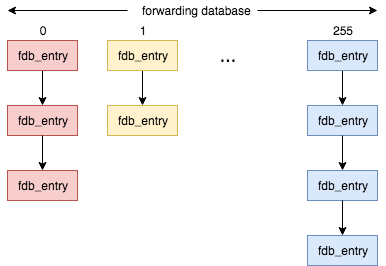
Table Entry Struct
net_bridge_fdb_entry is the element type of the aforementioned linked list.
struct net_bridge_fdb_entry
{
struct hlist_node hlist;
struct net_bridge_port *dst;
struct rcu_head rcu;
unsigned long updated;
unsigned long used;
mac_addr addr;
unsigned char is_local:1,
is_static:1,
added_by_user:1,
added_by_external_learn:1;
__u16 vlan_id;
};
Lookup
Since the implementation is a hash table, lookup is same as any hash table
lookup. The bridge looks up in the forwarding database when it wants to know
which port to forward a frame with a particular MAC address. Thus the key of the
hash table is the MAC address. First it gets the hash value of the MAC address by
br_mac_hash and then gets the linked-list from that table entry. Next it
iterates through the list and compare the MAC address with each element until it
finds the right one.
Update Entries
The operations of adding, updating and deleting an entry are all typical hash table operations. I won’t bother repeating how they work and only focus on when they happen.
- When an interface is added to the bridge (i.e. when
br_add_ifis called),br_fdb_insertis called to add the enslaved device’s MAC address to the forwarding database. - When a device on a local port changes its MAC address (For e.g. through
ifconfig eth0 ihw ether 11:22:33:44:55:66), the entry is updated in the forwarding table. - An entry is deleted when it expires. Each entry normally expires if it is not
used for a while. By default it is 5 minutes but it’s configurable.
br_fdb_cleanupis called regularly to clean up expired entries.
Frame Processing
Ingress data is first processed by netif_receive_skb, which is a generic
device-independent function. It calls rx_handler of the device on which the
data is received. Remember br_add_if registers a receive handler
br_handle_frame for the enslaved device? Here this handler will be called to
process data received on the device.
br_handle_frame does some sanity checking first, to ensure this frame is a
valid Ethernet frame. Then it checks whether the destination is a reserved
address, which means this is a control frame. Special processing is needed if
the answer is yes. Otherwise it calls br_handle_frame_finish to handle this
frame.
rx_handler_result_t br_handle_frame(struct sk_buff **pskb) {
const unsigned char *dest = eth_hdr(skb)->h_dest;
... (Validation code)
if (unlikely(is_link_local_ether_addr(dest))) {
/*
* See IEEE 802.1D Table 7-10 Reserved addresses
*
* Assignment Value
* Bridge Group Address 01-80-C2-00-00-00
* (MAC Control) 802.3 01-80-C2-00-00-01
* (Link Aggregation) 802.3 01-80-C2-00-00-02
* 802.1X PAE address 01-80-C2-00-00-03
*
* 802.1AB LLDP 01-80-C2-00-00-0E
*
* Others reserved for future standardization
*/
... (Special processing for control frame)
}
...
NF_HOOK(NFPROTO_BRIDGE, NF_BR_PRE_ROUTING, skb, skb->dev, NULL,
br_handle_frame_finish);
...
}
br_handle_frame_finish does the following steps:
- Learn the source MAC address and update the forwarding database.
- If the destination address is a multicast address, then
br_multicast_rcvis called to do some processing. - The decision of how to forward this frame depends on whether the destination address is a broadcast, multicast or unicast address. The rules are as follows:
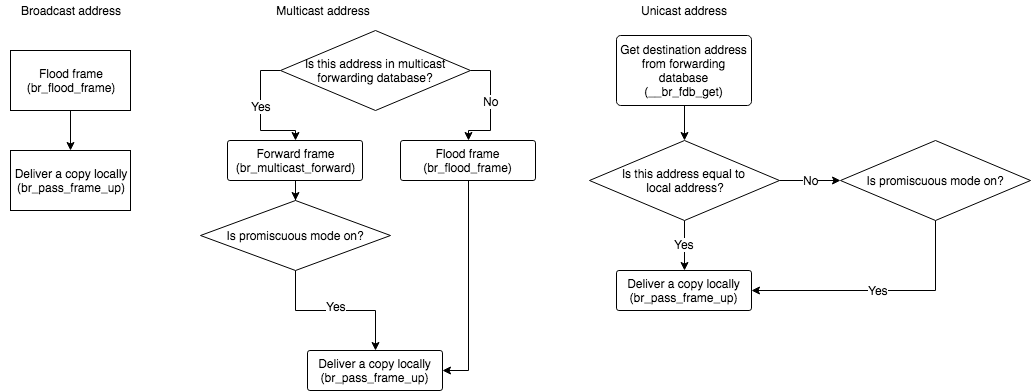
Note: if the interface is in promiscuous mode, then this frame will be delivered locally despite of the destination address. And promiscuous mode doesn’t necessarily need to be on because anyway this bridge handler will forward it.
The following figure from “Anatomy of a Linux bridge” may also help understand the frame processing.
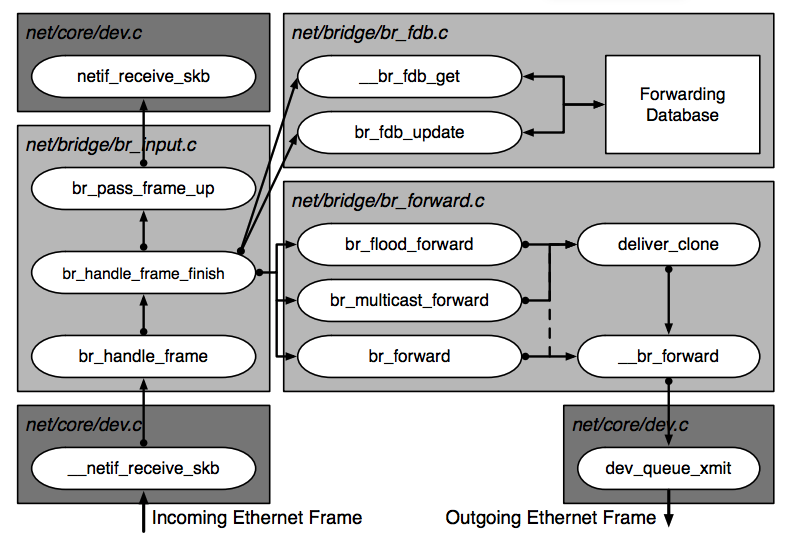
Conclusion
In this article, we discussed how Linux bridge is implemented and what happens
when we configure the bridge as well as how a frame is processed by the bridge.
Here is a lab that you can try. First add a bridge. Then start two VMs connected
to this bridge. Check out the bridge’s mac table by command brctl showmacs
br0. And see if you can ping between two VMs. You can also use tcpdump or
Wireshark to capture the traffic. Recall what happens when you do each step.
Reference
[1] Benvenuti, Christian. Understanding Linux network internals. “ O’Reilly
Media, Inc.”, 2006.
[2] Anatomy of a Linux
bridge
[3] Linux Bridge - how it works
